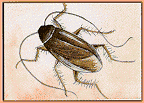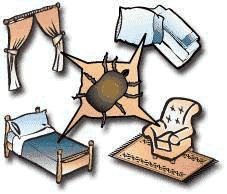Asthma and Allergies and their Environmental Triggers
Asthma and allergy attacks have increased in the United States despite the fact that our outdoor air quality has improved. Some researchers think these problems have increased because kids are spending too much time indoors.
When outdoors, we are exposed to pollens and dust, and other irritants. But when indoors, we are also exposed to "allergens." Allergens are proteins that originate from cockroaches, mold, pets, and dust mites (tiny bug-like creatures that live in dust). Allergens cause allergies.....and most people know that allergies can make you sniffle, sneeze, have runny and itchy eyes, and other cold-like symptoms. But allergens can also trigger asthma attacks, which are more serious. Asthma symptoms include wheezing (a high-pitched whistling sound heard when exhaling); coughing spells unrelated to a cold; shortness of breath, especially during exercise; and tightness in the chest. Allergic asthma affects about 3 million children (8 to 12 percent of all children) and 7 million adults in the United States each year!
Play our Dust Game
read the "Dustmitezilla" story
and learn more about
Air and Your World Indoors
roaches....
and dust mites...
What Can You Do?
Reduce the allergens from YOUR environment! Most children with asthma are allergic to something, and so staying away from the "allergen" should help control the asthma. If you have asthma or allergies, stay away from animals, remove the teddy bears, rugs, curtains and lamp shades in rooms that you stay in a lot, like the bedroom. Plastic mattress and pillow covers, exterminators for pesky bugs, and the elimination of dust-traps like curtains and rugs in your bedroom may help you breathe easier. Or if it's trees and pollen that get to you, air conditioning and air filters should help. Read a fun "make-believe" story about "Dustmitezilla" - a dust mite of giant proportions!
And Research Helps Too!
Children whose parents or brothers and sisters have asthma are more likely to develop it themselves. But even though our "genes" do play some part in whether or not we'll have asthma, researchers hope to make the most progress in fighting the disease by looking at the environmental aspect of asthma. The hope is that if kids encounter fewer allergens early in life, they'll be less likely to develop allergic responses. Asthma research is performed at NIEHS and at the National Institute of Allergy and Infectious Diseases.
NIEHS and the National Institute of Allergy and Infectious Disease are also working together on an effort to help asthma sufferers. The project is called TEAM, which stands for Targeting the Environment and Asthma Management.






